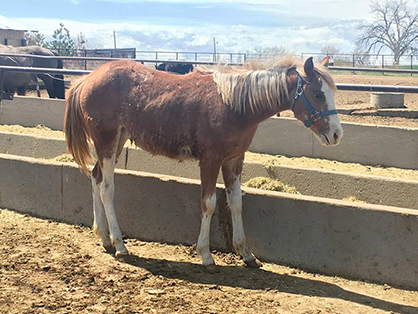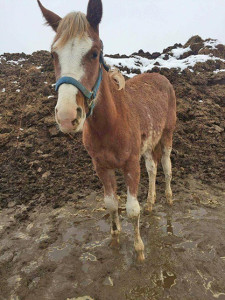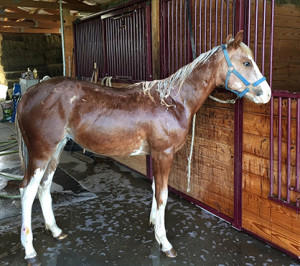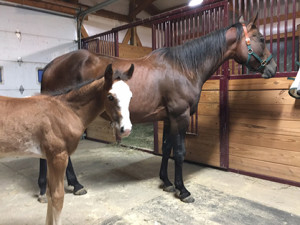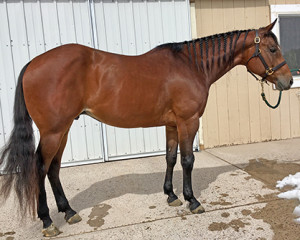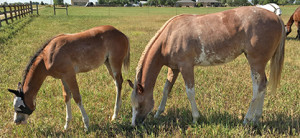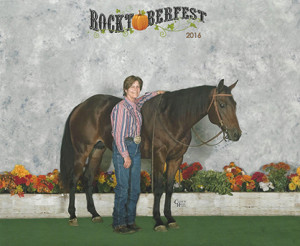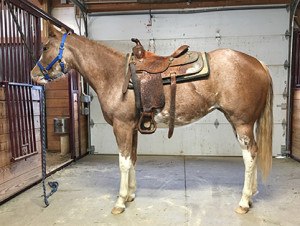From the Kill Pen to the Show Pen: The Brown Family
By: Brittany Bevis
Most people wouldn’t consider a kill pen to be the ideal location to find their next show horse prospect, but that’s exactly what happened for longtime horse enthusiast, Ann Hards. But for Ann, it was less about finding an addition to her show string as it was giving a young horse a chance to escape what she refers to as the horse welfare system.
As a self-described longtime, small-time breeder, Ann certainly breeds responsibly. But she’s also aware that she’s contributing to the overall horse population here in the United States.
“I’ve never rescued a kill pen horse before,” she says. “I’ve bred most of my horses, and the few that I have bought have always been from a trainer or small-time breeder, like myself. However, as the horse industry has changed over time, and the external organizations policing it have become more vocal, the problem of unwanted horses has become much more visible. As a small time breeder, I’m contributing to the general horse population, which makes me in some way responsible for the general horse population’s welfare.”
“I also know that at least one very nice, very well-bred horse that I sold in the past ended up in a bad situation. Fortunately, I was able to rectify that. Indeed, the more I have studied the situation, the more obvious it is that many really nice horses end up in bad places. Therefore, I’ve been looking for the right situation that would allow me to help a horse out of what I call the horse welfare system, ie. the system of low end sales, kill pens, and slaughter.”
For this project, Ann had a few criteria she was looking for. First, the horse had to be registered or registerable (preferably with AQHA or APHA). Second, the horse had to be reasonably young (under the age of 10). Third, the horse had to be free of the incumbencies that come along with most horses already ‘saved’ by most rescue groups, including things like contracts with no breeding clauses and no sale clauses, etc. So, with list in hand, Ann monitored websites and Facebook pages and waited.
An opportunity came in April of 2016 when Ann saw an online photo of a 13-month-old, undernourished Paint filly. “At that point, I contacted the kill pen representatives about purchasing her,” Ann says. “She stood 13 hands, was obviously malnourished, had injuries on three of four legs, and had a breeder’s certificate with her that read like a who’s who of the Western Pleasure world (The Investor, Investment Creditor, Invitation Only, and Sonny’s Calvin were all on her papers).”
The experience of going to the kill pen to pick up the young filly she nicknamed “Priceless” was sobering. “In the process of picking her up, I had to sort her out of a herd of about 25 horses, with several studs in the mix, all swirling in panic around a large cement footed pen. It was crazy, yet my new yearling filly let me catch, halter, and lead her out of that mess with ease. As soon as I took possession of her, she went to a quarantine facility where we immediately started working on her injuries. I went home with the breeder’s certificate to start thinking of names and searching the Internet for whatever information I could find about her. As soon as I googled her pedigree, I found her mother listed for sale in a upcoming local, low end auction, and she was in foal to Priceless’s sire.”
Although Ann had never seen the mare before, she felt a personal connection to the mother of her new filly and wanted to make sure she escaped the same fate that almost destroyed her daughter. “I went to the sale hoping to make sure that she wasn’t going to follow her daughter into the kill pen. The mare foaled a full sister to Priceless that morning, just before going into the sale ring. With a brand new baby on her side, the mare sold to a non-kill-buyer party, and I went home feeling like I had done my duty for this unknown mare. Also, I made contact with the person who bought her. A month later, they contacted me to say that they couldn’t get along with the mare and they had to get rid of her.”
The mare Ann saw at the sale looked remarkably different just one month later. She had gone from being in reasonable condition to a body score of a 2.5. “The buyer knew nothing about feeding a lactating mare and had given her one cup of grain and two flakes of hay per day since they took her home. She was literally starving in front of their eyes. I was pretty sure that her next stop would either be starving to death, being sent directly to a kill buyer, or being put in another low-end sale. I bought her first. So, now I owned an emaciated granddaughter of Invitation Only and her month old filly, a full sister to Priceless.”
After asking her Facebook friends for inspiration, the mare’s barn named became Molly Brown, Titanic survivor, “because she’s a survivor for sure,” Ann says. She created a Facebook page for the little herd, now known as The Brown Family, in an effort to document their journey.
By this point, Ann has pieced together a fairly complete history of all three mares, and she’s very grateful to those who’ve helped along the way by sorting out registration papers and assisting in getting the fillies grandfathered into various incentive programs.
Fortunately, the paperwork on all three horses was in good shape. Molly (registered with AQHA as Invitedcuzsheshot) has been transferred into Ann’s name, and APHA registered the yearling filly as Priceless Investment and the weanling filly as Baby Brown. Believing that both fillies have the pedigree to compete at any level, Ann also grandfathered them both into the APHA Breeders’ Trust and the NSBA Incentive Fund.
“I would like to say that any horse that finds him/herself in the horse welfare system has so much better a chance of getting out before they reach the slaughter end of the line, if they can be identified. I was willing to take the chance on Priceless because of the breeder’s certificate that was with her. Thoroughbreds and BLM mustangs can be identified by their tattoos. A branded horse also has an advantage. I feel strongly that the breed registries should change their policies to help individuals who rescue a horse, to identify that horse via the DNA technologies available today. If it makes a difference to only one horse then it has made a difference to the horse population.”
Following Priceless’s quarantine, Ann worked on healing the filly’s injuries and improving her nutrition. “She’s now 100% sound and, except for one scar, the rest of her injuries are just memories,” Ann says. Remarkably, Priceless grew over eight inches during 2016, going from 13 hands when she left the kill pen to 15.2 hands by the beginning of 2017. “She’s now just beginning her training under saddle. She moves like her breeding suggest that she should.”
Baby Brown is now 14.1 hands at 12 months, more than a hand bigger than her big sister was at the same age, proving the point that nutrition for young foals in the early stages is crucial. Ann believes she will perform well in Halter and hopes to show her in In-Hand Trail later this year.
Once Baby Brown was weaned, Molly was sent to Bill Bornes for an evaluation to see if she could be brought back from broodmare status to a performance horse. Ann says she has exceeded all expectations. “She’s a beautiful mover and very trainable. We’re hoping to have her ready for AQHA shows by mid 2017. With any luck, we will get her qualified for the AQHA World Show, although 2018 is probably more reasonable than 2017. Now, I’m looking forward to wherever this adventure takes me.”










